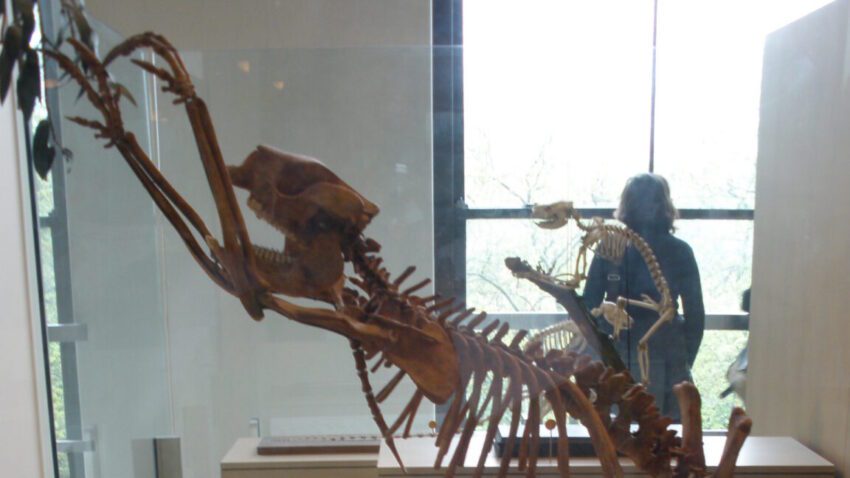
the first people to set foot in A recent archaeological discovery suggests that the first people to inhabit Australia were not primarily hunters of the continent’s megafauna but rather engaged in fossil collecting activities.
the first people to set foot in
New Insights into Australia’s First Peoples
Australia’s First Peoples have long been the subject of intense study and debate, particularly regarding their interactions with the continent’s megafauna. While there has been speculation about whether these ancient inhabitants hunted species such as the giant short-faced kangaroo to extinction, new findings indicate that their relationship with these creatures may have been more complex than previously thought. A team of archaeologists has uncovered evidence that suggests these early Australians were not just hunters but also collectors of fossils.
The Discovery of Fossilized Remains
The pivotal evidence in this new understanding comes from a fossilized leg bone of an extinct short-faced kangaroo, a species that roamed Australia during the Ice Age. Unlike their modern relatives, these kangaroos walked on their hind legs, utilizing a unique locomotion that involved placing their weight on the tips of single hoofed toes. The particular specimen studied was not fully grown at the time of its death, which has been dated to between 44,500 and 55,200 years ago using uranium-series dating techniques. This dating method relies on the decay of uranium isotopes found in the thin layer of rock that covers many fossils in Mammoth Cave, located in what is now Western Australia.
Cut Marks and Their Implications
What makes this discovery particularly intriguing is the presence of cut marks on the fossilized bone. Traditionally, such marks have been interpreted as evidence of butchery, indicating that early humans were hunting these animals for food. However, the new analysis suggests that these marks may instead represent an ancient attempt at fossil collecting. This interpretation challenges the prevailing narrative that humans were primarily responsible for the extinction of Australia’s megafauna through hunting.
As a result, the evidence shifts the focus from hunting practices to a more nuanced understanding of how early Australians interacted with their environment. It raises important questions about the motivations behind fossil collection and what this means for our understanding of the cultural practices of Australia’s First Peoples.
Revisiting the Megafauna Extinction Debate
The extinction of Australia’s megafauna has been a contentious topic among researchers. For decades, the prevailing theory has been that human activity, particularly hunting, played a significant role in the decline of these large animals. However, the new findings suggest that the relationship between humans and megafauna may not have been as straightforward as previously believed.
Alternative Theories of Extinction
Several alternative theories have been proposed to explain the extinction of Australia’s megafauna. These include:
- Climate Change: Some researchers argue that significant climatic shifts during the late Pleistocene epoch could have led to habitat changes that adversely affected megafauna populations.
- Ecological Competition: Another theory posits that competition among species for resources may have contributed to the decline of megafauna, particularly as smaller species adapted more effectively to changing environments.
- Human Impact: While hunting has been a focal point, other forms of human impact, such as habitat alteration through fire management practices, may have also played a role.
The new evidence of fossil collection adds a layer of complexity to these discussions, suggesting that early humans may have had a more varied relationship with the megafauna than merely that of hunter and prey.
Archaeological Context and Methodology
The research team employed rigorous archaeological methods to analyze the fossilized remains. The use of uranium-series dating provided a reliable timeframe for the specimens, allowing researchers to place the findings within a broader historical context. The analysis of cut marks was conducted using advanced imaging techniques, enabling a detailed examination of the bone’s surface.
This meticulous approach underscores the importance of interdisciplinary collaboration in archaeology, where insights from geology, anthropology, and paleontology converge to provide a more comprehensive understanding of ancient human behavior.
Implications for Cultural Understanding
The implications of this research extend beyond the realm of archaeology; they touch on cultural identity and heritage. Understanding that Australia’s First Peoples may have engaged in fossil collecting opens up new avenues for exploring their relationship with the land and its natural history. It suggests a reverence for the past and an appreciation for the natural world that transcends mere survival needs.
Moreover, this discovery invites a reevaluation of how Indigenous knowledge systems and practices can inform contemporary understandings of ecology and conservation. The recognition of early Australians as fossil collectors may also contribute to a broader narrative that respects and acknowledges Indigenous perspectives on land management and biodiversity.
Stakeholder Reactions and Future Research
The findings have sparked interest and discussion among various stakeholders, including archaeologists, Indigenous communities, and environmentalists. Many Indigenous leaders have expressed a desire for further research that incorporates traditional ecological knowledge, emphasizing the importance of collaboration between scientists and Indigenous peoples.
Future research will likely focus on expanding the scope of fossil analysis to include additional sites across Australia. By examining other fossilized remains and their contexts, researchers hope to build a more comprehensive picture of the interactions between early humans and megafauna.
Potential for New Discoveries
As archaeological techniques continue to advance, the potential for new discoveries remains high. The integration of technologies such as 3D imaging and DNA analysis could provide deeper insights into the behaviors and practices of Australia’s First Peoples. These innovations may also help clarify the timeline of human arrival in Australia and their subsequent interactions with the continent’s unique fauna.
Conclusion
The recent findings regarding the fossilized leg bone of an extinct kangaroo challenge long-held assumptions about the role of Australia’s First Peoples in the extinction of megafauna. By suggesting that these early inhabitants engaged in fossil collecting rather than primarily hunting, the research opens up new avenues for understanding their cultural practices and ecological interactions. As the debate surrounding megafauna extinction continues, this discovery serves as a reminder of the complexity of human-environment relationships and the need for ongoing research that respects and incorporates Indigenous knowledge.
Source: Original report
Was this helpful?
Last Modified: October 24, 2025 at 12:36 am
3 views















